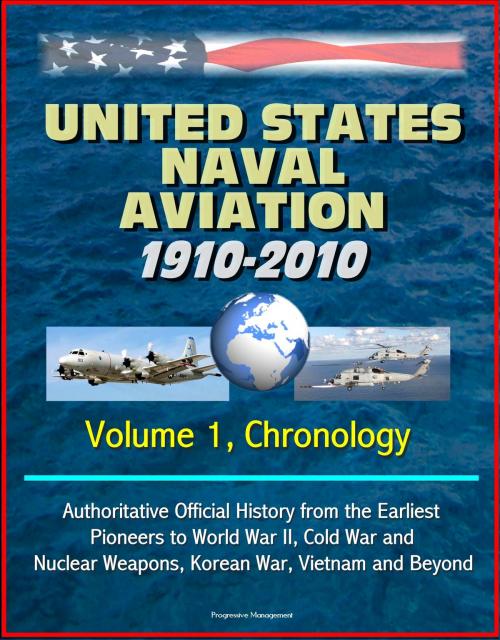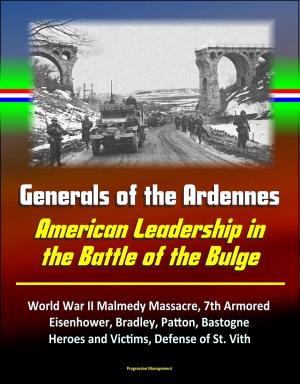United States Naval Aviation: 1910-2010 - Volume 1, Chronology: Authoritative Official History from the Earliest Pioneers to World War II, Cold War and Nuclear Weapons, Korean War, Vietnam and Beyond
Nonfiction, History, Military, Aviation, Naval| Author: | Progressive Management | ISBN: | 9781311536815 |
| Publisher: | Progressive Management | Publication: | February 15, 2016 |
| Imprint: | Smashwords Edition | Language: | English |
| Author: | Progressive Management |
| ISBN: | 9781311536815 |
| Publisher: | Progressive Management |
| Publication: | February 15, 2016 |
| Imprint: | Smashwords Edition |
| Language: | English |
Professionally converted for accurate flowing-text e-book format reproduction, this is the definitive official history of U.S. Navy aviation from its inception through 2010. United States naval aviation celebrated more than 100 years of service in 2010. Its story as told in these two volumes had its origins in the 1950s. The book was first published as United States Naval Aviation 1910–1960 and celebrated the first 50 years of naval aviation. Two subsequent editions added the decades of the 60s and 70s. A fourth edition brought the chronology up to 1995. This is the fifth update. Previous editions have proved an invaluable first-stop tool to aviation, naval, and military historians. This edition breaks U.S. naval aviation history into two volumes: Vol. I Chronology and Vol. II Statistics. Both have been greatly expanded over the previous edition beyond simply including years not previously covered. New and expanded research make these the definitive volumes on U.S. naval aviation's first century.
Chapter 1 A Few Pioneers 1898-1916 * Chapter 2 Test of Strength 1917-1919 * Chapter 3 The Roaring Twenties 1920-1929 * Chapter 4 The Great Depression 1930-1939 * Chapter 5 World War II 1940-1945 * Chapter 6 The Cold War 1946-1949 * Chapter 7 The Korean War 1950-1953 * Chapter 8 The New Navy 1954-1959 * Chapter 9 On The Brink 1960-1969 * Chapter 10 Defeat and Decline 1970-1979 * Chapter 11 The 600-Ship Navy 1980-1989 * Chapter 12 From the Sea 1990-1999 * Chapter 13 The Dawn of the Twenty-first Century 2000-2009
This volume documents the people and events that proved crucial to naval aviation's history. The work expands upon the previous chronological format by providing additional information of campaigns and technical aspects, and it provides the researcher and the Navy a more detailed account of specific subjects pertinent to better understanding its history. This edition, while attempting to maintain the professional standards established by the previous editions, also corrects errors and omissions in the preceding volumes.
The United States Navy's official interest in airplanes emerged as early as 1898. That year the Navy assigned officers to sit on an interservice board to investigate the military possibilities of Samuel P. Langley's flying machine. In subsequent years naval observers attended air meets in the United States and abroad, and public demonstrations staged by Orville and Wilbur Wright in 1908 and 1909. These men became enthusiastic about the potential of airplanes as fleet scouts, and by 1909, many naval officers, including a bureau chief, urged the purchase of aircraft.
The next year the Navy made a place for aviation in its organizational structure when Capt. Washington. Chambers was designated as the officer to whom all aviation matters were to be referred. Although holding no special title, he pulled together existing threads of aviation interest within the Navy and gave official recognition to the proposals of inventors and builders. Before the Navy had either planes or pilots, he arranged a series of tests in which civilian aircraft designer and entrepreneur Glenn H. Curtiss and Eugene B. Ely, a pilot who worked for Curtiss, dramatized the airplane's capability for shipboard operations and showed the world and a skeptical fleet that aviation could go to sea.
Professionally converted for accurate flowing-text e-book format reproduction, this is the definitive official history of U.S. Navy aviation from its inception through 2010. United States naval aviation celebrated more than 100 years of service in 2010. Its story as told in these two volumes had its origins in the 1950s. The book was first published as United States Naval Aviation 1910–1960 and celebrated the first 50 years of naval aviation. Two subsequent editions added the decades of the 60s and 70s. A fourth edition brought the chronology up to 1995. This is the fifth update. Previous editions have proved an invaluable first-stop tool to aviation, naval, and military historians. This edition breaks U.S. naval aviation history into two volumes: Vol. I Chronology and Vol. II Statistics. Both have been greatly expanded over the previous edition beyond simply including years not previously covered. New and expanded research make these the definitive volumes on U.S. naval aviation's first century.
Chapter 1 A Few Pioneers 1898-1916 * Chapter 2 Test of Strength 1917-1919 * Chapter 3 The Roaring Twenties 1920-1929 * Chapter 4 The Great Depression 1930-1939 * Chapter 5 World War II 1940-1945 * Chapter 6 The Cold War 1946-1949 * Chapter 7 The Korean War 1950-1953 * Chapter 8 The New Navy 1954-1959 * Chapter 9 On The Brink 1960-1969 * Chapter 10 Defeat and Decline 1970-1979 * Chapter 11 The 600-Ship Navy 1980-1989 * Chapter 12 From the Sea 1990-1999 * Chapter 13 The Dawn of the Twenty-first Century 2000-2009
This volume documents the people and events that proved crucial to naval aviation's history. The work expands upon the previous chronological format by providing additional information of campaigns and technical aspects, and it provides the researcher and the Navy a more detailed account of specific subjects pertinent to better understanding its history. This edition, while attempting to maintain the professional standards established by the previous editions, also corrects errors and omissions in the preceding volumes.
The United States Navy's official interest in airplanes emerged as early as 1898. That year the Navy assigned officers to sit on an interservice board to investigate the military possibilities of Samuel P. Langley's flying machine. In subsequent years naval observers attended air meets in the United States and abroad, and public demonstrations staged by Orville and Wilbur Wright in 1908 and 1909. These men became enthusiastic about the potential of airplanes as fleet scouts, and by 1909, many naval officers, including a bureau chief, urged the purchase of aircraft.
The next year the Navy made a place for aviation in its organizational structure when Capt. Washington. Chambers was designated as the officer to whom all aviation matters were to be referred. Although holding no special title, he pulled together existing threads of aviation interest within the Navy and gave official recognition to the proposals of inventors and builders. Before the Navy had either planes or pilots, he arranged a series of tests in which civilian aircraft designer and entrepreneur Glenn H. Curtiss and Eugene B. Ely, a pilot who worked for Curtiss, dramatized the airplane's capability for shipboard operations and showed the world and a skeptical fleet that aviation could go to sea.















